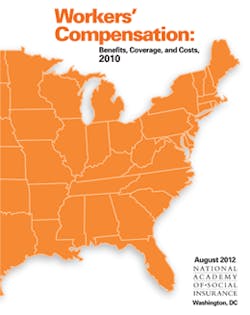Report: Workers’ Compensation Costs, Benefits Decline in 2010
The report, “Workers' Compensation: Benefits, Coverage and Costs, 2010,” reveals that workers’ comp benefits in the United States dropped .07 percent to $57.5 billion in 2010 compared to 2009. Employers’ costs for workers’ comp benefits, meanwhile, declined 2.7 percent in 2010 and were the lowest (as a share of covered wages) since 1980.
The report attributes this decline in part to a slow economic recovery and a 2.1 percent drop in medical benefits for injured workers.
"Employers' costs as a percent of payroll declined in 43 jurisdictions," said John F. Burton, Jr., chair of the study panel that oversees the report. "This decline is probably due to the slow pace of the recovery, with many jurisdictions still experiencing relatively high unemployment rates."
Most states reported a decrease in the number of workers covered but an increase in covered wages between 2009 and 2010. During the same period, the total amount of benefits paid to injured workers declined in 26 jurisdictions and increased in 25. As a share of payroll, benefits paid to injured workers fell by three cents to $0.99 per $100 of payroll in the nation.
National and State Trends
NASI has produced this report annually since 1997. Key estimates and trends from this year’s report include:
- Nationwide, medical payments decreased by 2.1 percent in 2010, to $28.1 billion, but cash benefits to injured workers increased by 0.7 percent, to $29.5 billion.
- Costs to U.S. employers fell by 2.7 percent in 2010 to $71.3 billion. As a share of covered wages, employers’ costs were lower than in any year since 1980.
- Measured as a percentage of the wages of covered workers, benefits paid to workers also fell in 2010.
- In 2010, workers’ compensation covered an estimated 124.5 million workers, a decrease of 0.3 percent from the previous year. Aggregate wages of covered workers increased by 2.6 percent.
- Most individual states reported a decrease in numbers of workers covered and an increase in covered wages between 2009 and 2010.
- In 2010, the share of benefits paid for medical care exceeded 50 percent in 32 states.
- In recent years, the importance of state funds as a source of workers’ compensation benefits has been declining.
- Between 2009 and 2010, the employers’ costs of workers’ compensation as a percent of payroll increased in 8 states and declined in 43 jurisdictions.
The share of medical benefits for workers' comp has increased substantially over the last 40 years, the report authors explained. During the 1970s, medical benefits nationally accounted for 30 percent of total benefits, whereas in 2010 the share of benefits paid for medical care was almost 50 percent. Experts attribute this trend to the rising cost of health care.
Download the NASI report to learn more.
About the Author

Laura Walter
Laura Walter was formerly senior editor of EHS Today. She is a subject matter expert in EHS compliance and government issues and has covered a variety of topics relating to occupational safety and health. Her writing has earned awards from the American Society of Business Publication Editors (ASBPE), the Trade Association Business Publications International (TABPI) and APEX Awards for Publication Excellence. Her debut novel, Body of Stars (Dutton) was published in 2021.

